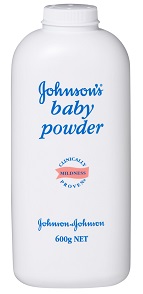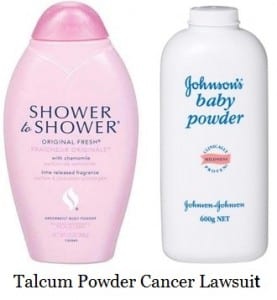 Black women who reported regular use of talcum body powder were at greater risk for ovarian cancer compared to their peers who didn’t use talc, according to a new study. That is not good news for Johnson & Johnson, which already faces several Talcum Powder Cancer Lawsuits across the country. J&J’s own documents have shown in talc powder ovarian cancer trials that the company actually targeted black women to increase talcum powder sales.
Black women who reported regular use of talcum body powder were at greater risk for ovarian cancer compared to their peers who didn’t use talc, according to a new study. That is not good news for Johnson & Johnson, which already faces several Talcum Powder Cancer Lawsuits across the country. J&J’s own documents have shown in talc powder ovarian cancer trials that the company actually targeted black women to increase talcum powder sales.Contrary to previous studies that showed talc used for ‘feminine hygiene’ raised the risk of ovarian cancer, researchers for this study reported a link between regular talcum powder use and ovarian cancer regardless of where women used it. Women who used talc on their genital areas experienced more than a 40 percent increased risk of cancer; those who used talc powder only on non-genital areas increased their ovarian cancer risk by more than 30 percent.
Talc an Avoidable Cancer Risk
Lead investigator Joellen Schildkraut told Reuters Health in a telephone interview, “African-American women have been targeted for use of body powder, and they use it more commonly. “I’ve concluded: why use it?”
An epidemiologist at the University of Virginia in Charlottesville, Ms. Schildkraut had been skeptical about whether talc used on genital areas could cause deadly ovarian cancer. Her new study, according to Reuters, along with other recent research studies, have convinced her to advise women to avoid talcum powder.
“It’s an avoidable risk for ovarian cancer,” she said.
Ms. Schildkraut’s research team interviewed 584 black women with ovarian cancer and 745 black women without it from southern, eastern and midwestern U.S.
Nearly 63 percent of the women with ovarian cancer and some 53 percent of the healthy women in the control group used talcum powder, reported the researchers in Cancer Epidemiology.
Black Women Underrepresented
The National Cancer Institute’s head of clinical epidemiology, Dr. Nicolas Wentzensen, said black women are underrepresented in many epidemiological studies.
Dr. Wentzensen via email told Reuters Health that Ms. Schildkraut’s research was well-conducted, that it confirms previous studies linking talc use with an increased ovarian cancer risk. Dr. Wentzensen also noted the study found stronger associations between talc use and ovarian cancer than had previous research. A December 2015 paper in the journal Epidemiology, for example, reported a 33 percent higher risk of ovarian cancer in women who said they routinely applied talc to genitals, sanitary napkins, tampons, underwear.
Black women in the past have reported significantly higher use of so-called feminine hygiene products both on the body generally and on genitals. A 2015 case-control study in Los Angeles found 44 percent of black women reported talcum powder use, compared to 30 percent of white women and 29 percent of Hispanic women.
Talc Cancer Risk Greater for Black Women Targeted
Johnson and Johnson outlined a plan in the 1990s to increase talcum powder sales “by targeting” black and Hispanic women. This fact was made clear in a company memorandum made public in recent lawsuits leading to $72 million and $55 million verdicts against Johnson & Johnson and an associated talc maker.
Prospective Studies Questioned
Prospective studies that follow participants over time are typically considered more reliable than studies that look backward, and two prospective studies have failed to link talc with ovarian cancer. However, Ms. Schildkraut believes the two prospective studies cited by J&J defense lawyers and myriad media defenders of J&J included too few talc users and too few women with ovarian cancer to unveil a relationship.
Because black women tend to use talc more, Ms. Schildkraut believes that studying a sizable group of black women, as she did, makes the study more relevant and might explain the stronger association.
Dr. Wentzensen said recall bias, particularly following large jury verdicts, might explain the stronger association in the new study. Ms. Schildkraut said she considered recall bias, but tends to believe women were more likely to correctly remember their use of talc.
20,000 Ovarian Cancer Cases Yearly
Every year, an estimated 20,000 American women are diagnosed with ovarian cancer, an estimated 14,500 of whom die, according to the CDC.
Dr. Daniel W. Cramer, who heads the Obstetrics and Gynecology Epidemiology Center at Brigham and Women’s Hospital in Boston, first reported a link between genital talc and ovarian cancer in 1982. Since then, he’s been calling for warning labels.
In a recent editorial in Gynecologic Oncology, cancer genetics expert Dr. Steven Narod of Women’s College Research Institute in Toronto wrote, “In the interests of public health, I believe we should caution women against using genital talcum powder.” Narod also wrote that it’s “disingenuous to state that there is no evidence that talc is associated with ovarian cancer.”
Free Legal Consultation
Matthews & Associates Law Firm is handling talc-ovarian cancer cases nationwide. If you or someone your love has been diagnosed with ovarian cancer after using talcum powder, call us for a free legal consultation.
Related
- Talcum Powder Cancer Lawsuit
- J&J Baby Powder Propaganda
- $72 Million Verdict in Talcum Powder Lawsuit
- Talcum Powder Cancer Verdict changes Game
- Talc linked to Ovarian cancer in Black Women (Reuters)

by Matthews & Associates




